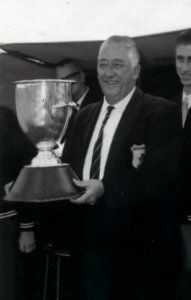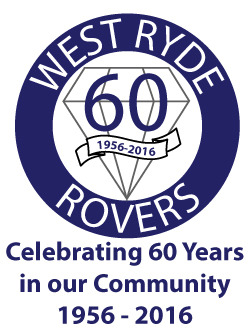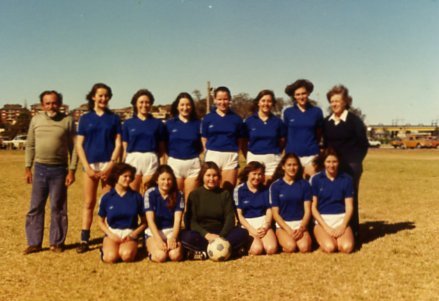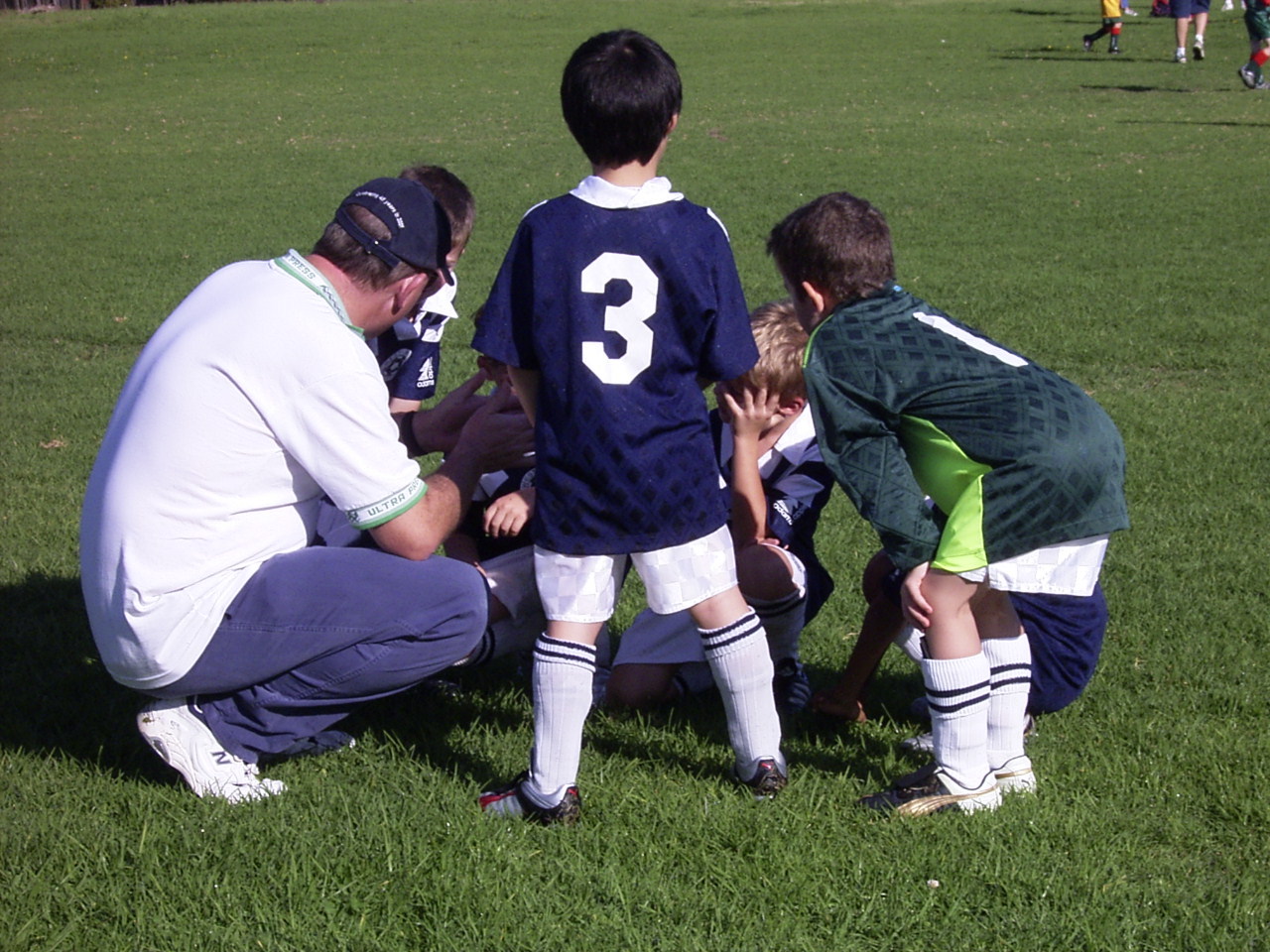West Ryde Rovers began life as a sporting club in 1956, by local resident Lester Harry Waud. He decided it was high time that the children of West Ryde were provided with some form  of organised sport and together with Perce Rouse, he set about founding the West Ryde Rovers Football Club (WRRFC).
of organised sport and together with Perce Rouse, he set about founding the West Ryde Rovers Football Club (WRRFC).
It wasn’t until 1958 that WRRFC saw its first two teams compete in the local Hornsby-Epping Soccer Association competition. That first year there were just two teams, U12 and U14 teams, but that was the seedling that grew into the West Ryde Rovers Sports & Social Club, which over 50 years later is now arguably the largest sporting club in the Ryde district.
The Club’s home ground was at Meadowbank Park, roughly where the main field next to the cul-de-sac (Ross Smith Avenue) is located today. However the growth of the Club saw much of the vacant land become available for recreational use and more fields started to appear.
The kits for these two teams in 1958 were made out of pyjama material and each shirt was individually made by Lester Waud’s wife Mavis.
In 1959, teams were added to the U16, U18 and All Age competitions and it wasn’t long before that number increased at a rapid rate.
 WRRFC first successful team was the U18 team in 1960, which featured arguably Rovers best ever junior player - David Zeman. Zeman would eventually go and play for top NSW State League side Sydney Prague and also represent the Socceroos in the 1970 World Cup qualifiers, making four (4) appearances in total. Zeman would later return to West Ryde Rovers in 1973 and led them to its highest level of competition, when it played in the NSW Federation semi-professional competitions (see below for more information).
WRRFC first successful team was the U18 team in 1960, which featured arguably Rovers best ever junior player - David Zeman. Zeman would eventually go and play for top NSW State League side Sydney Prague and also represent the Socceroos in the 1970 World Cup qualifiers, making four (4) appearances in total. Zeman would later return to West Ryde Rovers in 1973 and led them to its highest level of competition, when it played in the NSW Federation semi-professional competitions (see below for more information).
This U18 team would instantly progress up to All Age football with West Ryde Rovers and in 1964 the majority of these players would go on to win the All Age Division 1 title.
Lester Waud (Jnr) remembers watching All Age games at Meadowbank Park playing against the likes of Epping Eastwood and Eastwood St Andrews to crowds that were three deep in places. The popularity of Rovers among the local community was there for all to see and big crowds were common on Saturday afternoons down at Meadowbank Park. All the while the number of teams increased from year to year and by 1971, there were 19 soccer teams, which included the 2 Federation teams.
1980 was a significant year for WRRFC , when they entered the first teams in the Gladesville Hornsby Women’s Soccer Association (now the North West Sydney Women’s Federation), although this only lasted for five seasons. It wasn’t until 2001 that Rovers once again fielded women’s and girl’s teams, where we now have over 10 teams playing from U10’s through to All Age.
At the start of the new millennium, Rovers had 21 competitive soccer teams (U9-O35’s) plus many more mini teams.
In 2007, Rovers were approached by a group of players, who were looking to play in the GHFA O35 Division 1 competition. Among the players that featured in this team were a large number of former National Soccer League players including Nick Plataniotis, Tom Pontidas, Lee Sutherland, George Kalogeras, David Barrett, Terry Patalis, Martin Bourke and Peter Vezos. This was a very talented team with strong ambitions and they strolled through the competition undefeated. Unfortunately in the final they had to settle for joint champions, after a frustrating 0-0 draw. The team would go on to become Rovers first ever Champion of Champions winners.
The following year saw the nucleus of this squad joined by some more notable acquisitions, none more so than former Socceroos captain Paul Okon, who had only finished playing with Newcastle Jets in the A-League competition in 2006. He was joined by fellow Socceroos Francis Awaritefe, Kimon Taliadoros and Chris Kalantzis. This team would also go onto to dominate the competition, but in trying to defend their Champions of Champions title, they had to settle for runners-up after being defeated by an Alex Tobin led Castle Hill United
This unfortunately though would be the last time we would see this group of players together at the Club.In 2009, the club took another significant step, when it gained admittance into the GHFA Super League competition, the second highest level for All Age c
ompetitions. So far it has proved a tough slog, however it’s the aim of the Soccer Committee to see many of our junior players aspire to play for our ‘senior’ teams in the years to come and one day win promotion to the GHFA Premier League competition.
NSW Federation of Soccer Clubs
In 1968, the Soccer Club decided to enter teams into the NSW Federation of Soccer Clubs Inter-Suburban League 3rd Division competition. At the time this was a fairly big step for the club, as this competition included clubs from right across Sydney and was the stepping stone towards semi-professional soccer. It was a modest start with both the 1st and 2nd grade teams finishing in the bottom half of the table.
The next year, the Rovers 2nd grade team finished in 4th position and participated in the finals.
1970 saw the club finish mid-table, but the next three years proved to be the most successful period in the Club’s history.
71 and 72 proved to be very successful years for the Club, as it moved up the Inter-Suburban Divisions. In 1972 both senior teams made the Grand Final. 1st grade beat Queens Park in a pulsating final, while 2nd grade smashed Sydney University 4-1. This success moved Rovers to within one division of what most called 'Federation Football' or semi professional status.
So by 1973, Rovers had progressed to the Inter-Suburban 1st Division and it proved to be another successful year. Interestingly, it was a battle with near neighbours Gladesville Ravens that ensued throughout the season and had supporters of both clubs nervously approaching the end of the season. In 1st grade, both teams finished with 30 points at the top of the table, but Ravens finished Premiers courtesy of a superior goal difference. Rightly so, the two teams met in the Grand Final and it was Rovers getting home 1-0 and this ensured their promotion to Federation football.
1974 saw Rovers promoted to the semi-professional 3rd Division and required the club to field three grades. The 2nd and 3rd grade teams struggled, but the same couldn’t be said for 1st grade, as they stunned everyone to finish in 4th place. Interestingly arch rival Gladesville Ravens finished last. There however was no grand final success repeat, as they went out in the semi finals to a very strong Arncliffe Scots side.
Rovers remained in the 3rd Division competition for the next 5 years, but there was to be no more success, as the demands of semi-professional soccer were hitting home. The closest they came to success in this period, was in 1976, Rovers 3rd Grade finished runners-up after a narrow 2-1 grand final defeat to Ku-Ring-Gai.
In 1980, Rovers was relegated down to the top amateur division and it was evident the zest to play and travel all across Sydney had just about worn thin and 1981 proved to be their last year at this level, as the Club decided to concentrate on the juniors in the Gladesville-Hornsby Soccer Association.

In 1956, Lester Waud created a sports club in the West Ryde area to enable local kids to be involved and integrated into team sports. Lester with some friends and volunteers then went on to craft out the Rovers home ground, LH Waud Field located at Meadowbank Park.
Since this time, West Ryde Rovers has grown to be the biggest Community Sports Club in the Ryde municipality and covers not only Football, but Cricket and Netball as well, incorporating over 2000 playing members.
WRRFC is committed to continually develop and promote grassroots football within our Community, and is dedicated to work with football stakeholders to provide a secure, family-orientated football environment, free from any form of abuse, intolerance or racism.




